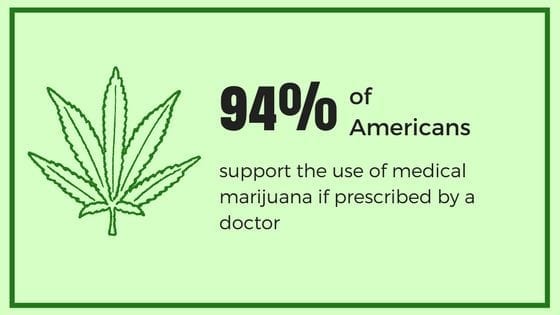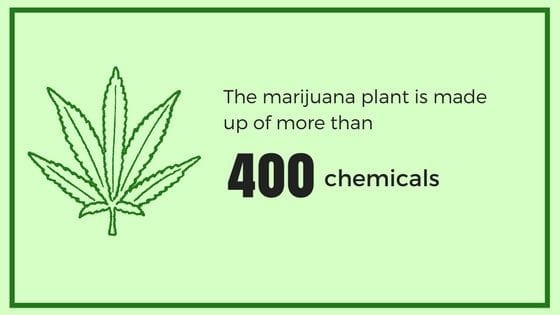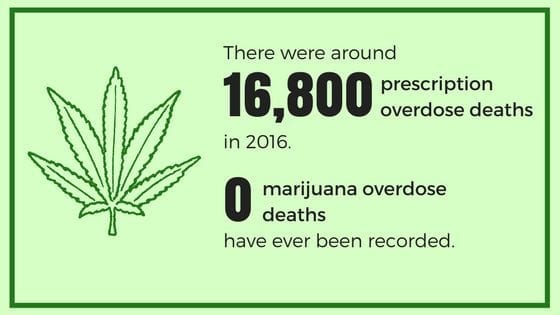Marijuana was valued for its healing powers in many ancient cultures. In ancient Greece, cannabis cured inflammation. In India, it was offered as a cure for leprosy. In China, it was used for just about everything. By 1850, marijuana was listed in the United States Pharmacopeia and was considered acceptable for use in curing many ailments. By 1970, the substance was prohibited in the United States.
Our bodies contain both opioid and cannabinoid receptors which are part of systems known to control pain and regulate mood. But while cannabis remains federally prohibited, opioid use for pain and illicit purposes is continually on the rise.
A nation in pain
In 2015, more than one third of Americans were prescribed opioids. According to the CDC, nearly half of the opioid overdose deaths reported in 2015 involved a prescription opioid. Opioids are still considered an appropriate first line of treatment for those suffering with chronic pain despite abuse potential in many of these legal drugs and a national and global opioid epidemic at hand.
Treating chronic pain is difficult. Patients often show little to no physical symptoms, and doctors must rely on a patient’s account of their own pain to devise possible solutions. Each patient is different, therefore patient responses to treatment options exist on a spectrum. Given the epidemic at hand and the variety of responses to pain treatments, doctors are exploring marijuana as a possible pain treatment option for chronic pain patients. As in the case of medication-assisted treatment, this pain treatment option has not risen to the forefront of alternative pain treatment discussion without controversy.
Marijuana under the law
Marijuana is currently legal for medical or recreational purposes in 29 US states and Guam, Puerto Rico, and Washington DC. Regardless, the Drug Enforcement Administration classifies cannabis as a schedule I drug along with heroin, LSD, and MDMA under federal law. A schedule I drug is defined as one with high abuse potential, not federally accepted for medical use, and not accepted for safe use. Though the federal government identifies marijuana as a dangerous and illicit substance, a Quinnipiac poll from 2017 found that 94% of Americans support medical cannabis.

Cannabis controversy
Though many Americans have voiced and voted their support for medical marijuana, doctors and other professionals remain skeptical of the plant’s medical value. Most of the hesitancy arises from a vast gap in research that leaves important information about medical cannabis unknown. Much of the language in this article includes what “may be” or “is possible” because a lot remains to be learned.
What we do know is that medical marijuana does appear to create mild negative side effects, even at a low dose. Some patients involved in medical cannabis studies reported experiencing short-term neurologic side effects such as impaired attention, memory and concentration. Long term side effects are widely unknown and unstudied. For those with psychotic disorders or at risk of developing them, medical cannabis may be a gamble.

The term “medical marijuana” lacks a precise definition and chemical composition. Medical marijuana can be smoked or ingested and can contain more of the psychoactive effect inducing chemical tetrahydrocannabinol (THC) in some products and more cannabidiol (CBD) in others. Products that are ingested are often created in labs with fixed molecular compositions. Marijuana plants, in contrast, contain over 400 chemicals in various arrangements. Dispensaries in states where medical marijuana is legal are not required to disclose the CBD to THC ratio in their products to patients.
Possible benefits
According to the CDC, prescription opioid overdoses were the cause of death of around 16,800 Americans in 2016. Marijuana, in contrast, has no known lethal dose and no marijuana overdose has ever been reported. From a harm reduction standpoint, medical marijuana is a much safer option when compared to prescription opioids.

Recent reports show that patients are using medical cannabis in place of opioids, using less medication, and dying less from opioid overdose when medical marijuana is offered as a medical option. In a large California study of medical cannabis patients, 97% of those who used opioids reported a reduction in the use of opioids when on medical cannabis. Furthermore, evidence in several studies suggests that low-dose medical marijuana is associated with pain reduction in neuropathic pain patients using other analgesics at the same time.
An article in the Harm Reduction Journal titled, “Rationale for cannabis-based interventions in the opioid overdose crisis” details three areas of opportunity for cannabis to reduce opioid use disorders and the negative side effects associated with them. First, cannabis can be used as a first line treatment, potentially eliminating the need for some patients to begin opioid therapy, therefore eliminating their risk of opioid use disorder or overdose. Second, cannabis can be used in tandem with opioid therapy, to reduce the dosage of opioids required to treat a patient. Third, medical marijuana can be used in the treatment phase of those struggling with opioid use disorder to increase treatment success rates.
The search for a solution continues
There is much to be explored and researched in the realm of medical marijuana. Despite some potential, disturbing side effects, patients react in different ways to treatment with medical cannabis as they do with opioid therapy.
The team here at Inflexxion is currently analyzing data from our ASI-MV and WIS systems to see what we can learn about the use and effects of cannabinoid products from various populations. Stay tuned for more to come.





